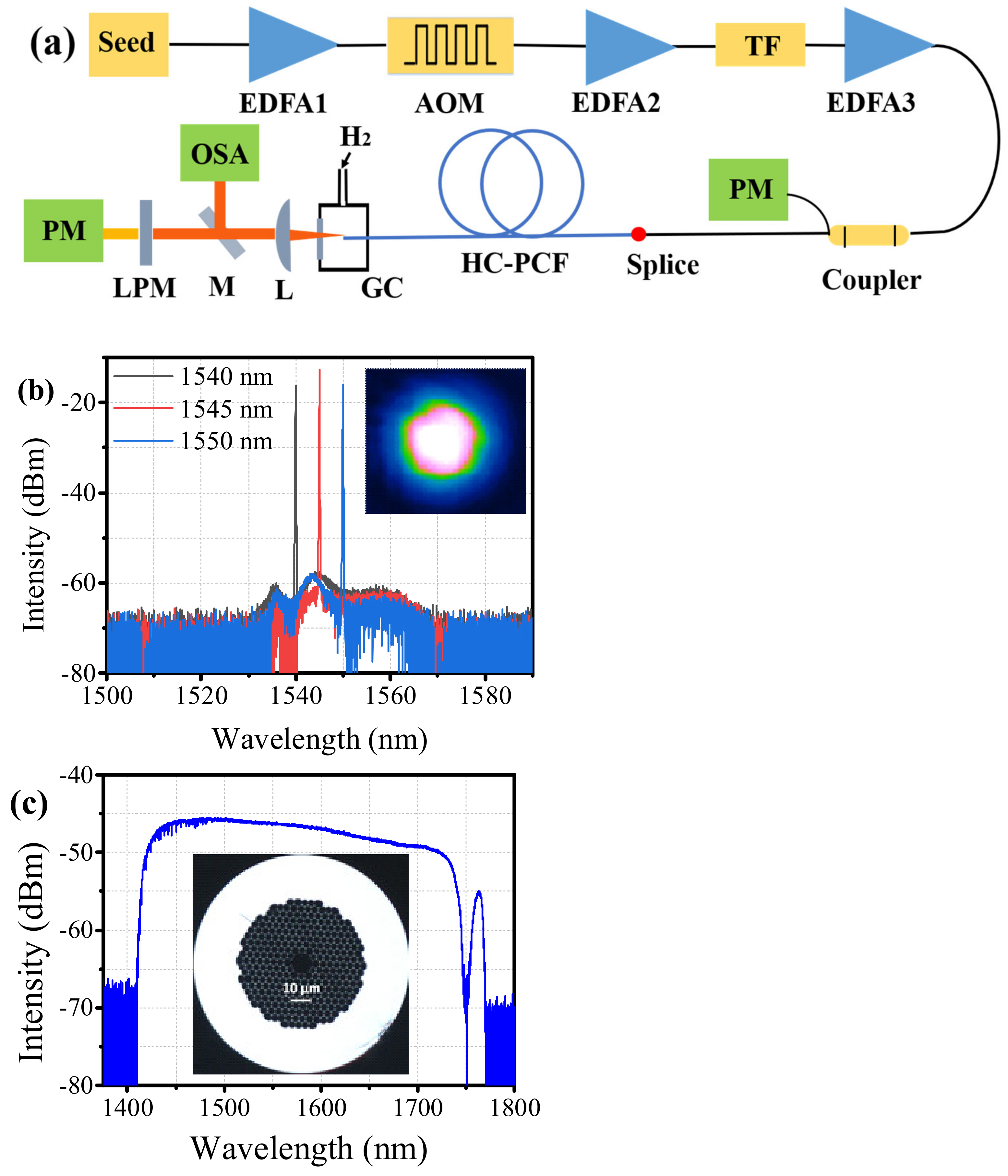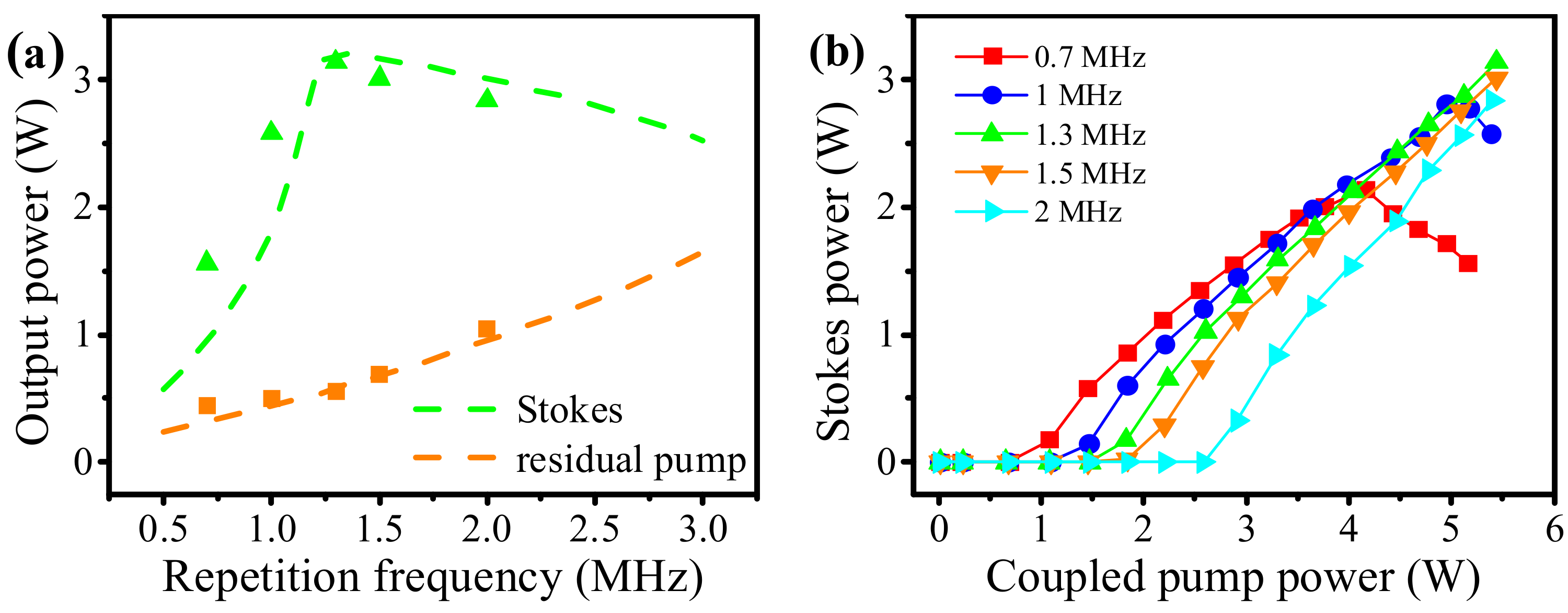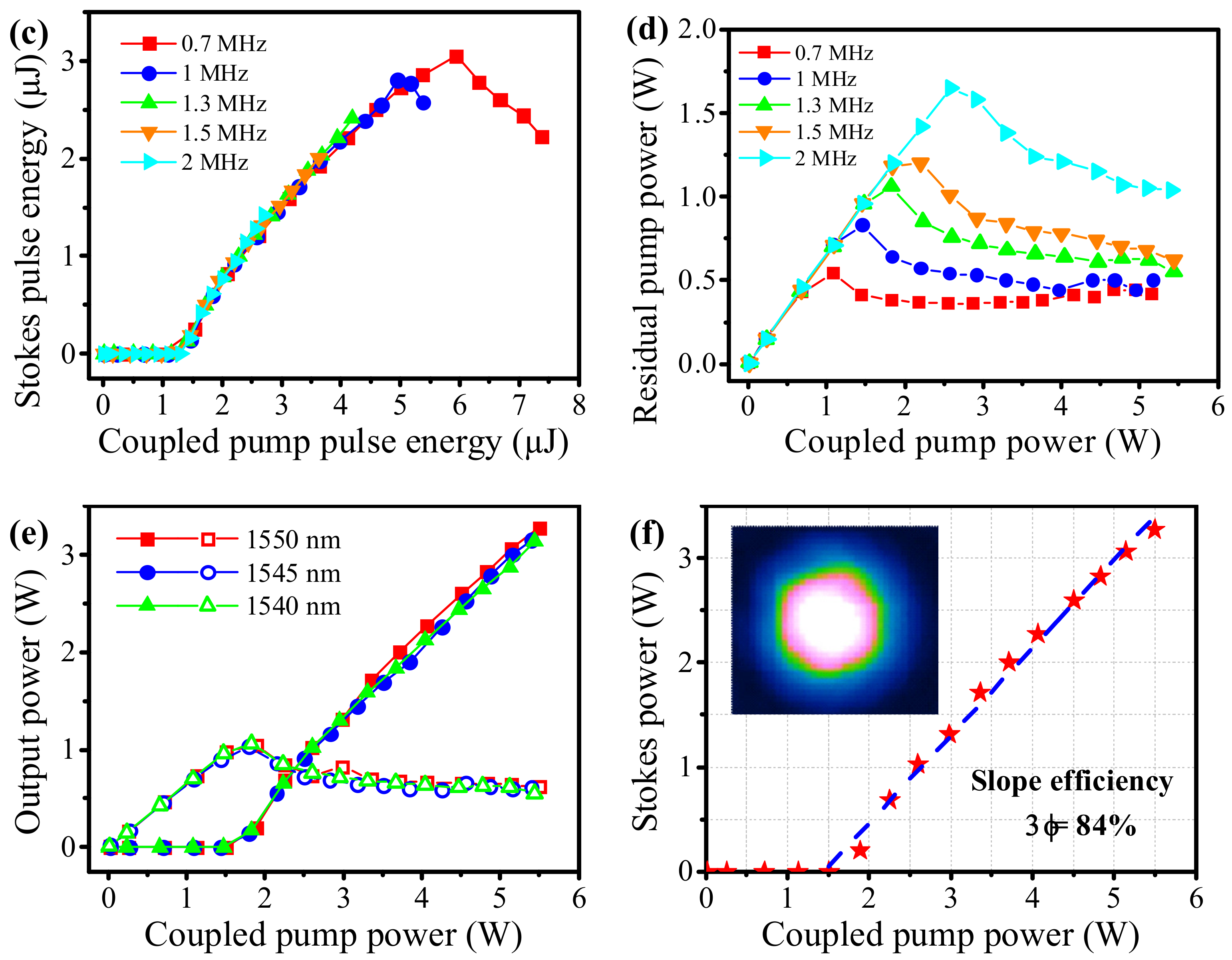Highly Efficient Nanosecond 1.7 ?m Fiber Gas Raman Laser by H2-Filled Hollow-Core Photonic Crystal Fibers
Abstract
:1. Introduction
2. Experimental Setup
3. Results and Discussion
4. Conclusions
Author Contributions
Funding
Data Availability Statement
Conflicts of Interest
References
- Zhang, Y.; Zhang, P.; Liu, P.; Han, K.; Du, Q.; Wang, T.; Zhang, L.; Tong, S.; Jiang, H. Fiber light source at 1.7 μm waveband and its applications. Chin. J. Lasers 2016, 53, 090002. [Google Scholar]
- Burns, M.D.; Shardlow, P.C.; Barua, P.; Jefferson-Brain, T.L.; Sahu, J.K.; Clarkson, W.A. 47 W continuous-wave 1726 nm thulium fiber laser core-pumped by an erbium fiber laser. Opt. Lett. 2019, 44, 5230–5233. [Google Scholar] [CrossRef] [PubMed]
- Zhang, L.; Dong, J.; Feng, Y. High-Power and High-Order Random Raman Fiber Lasers. Quantum Electron. 2018, 24, 1–6. [Google Scholar] [CrossRef]
- Zhang, Y.; Song, J.; Ye, J.; Xu, J.; Yao, T.; Zhou, P. Tunable random Raman fiber laser at 1.7 μm region with high spectral purity. Opt. Express 2019, 27, 28800–28807. [Google Scholar] [CrossRef]
- Cheng, H.; Tong, S.; Deng, X.; Liu, H.; Du, Y.; He, C. Deep-brain 2-photon fluorescence microscopy in vivo excited at the 1700 nm window. Opt. Lett. 2019, 44, 4432–4435. [Google Scholar] [CrossRef]
- Horton, N.G.; Xu, C. Dispersion compensation in three-photon fluorescence microscopy at 1,700 nm. Biomed. Opt. Express 2015, 6, 1392–1397. [Google Scholar] [CrossRef] [Green Version]
- Kawagoe, H.; Ishida, S.; Aramaki, M.; Sakakibara, Y.; Omoda, E.; Kataura, H. Development of a high-power supercontinuum source in the 1.7 μm wavelength region for highly penetrative ultrahigh-resolution optical coherence tomography. Biomed. Opt. Express 2014, 5, 932–943. [Google Scholar] [CrossRef] [Green Version]
- Li, C.; Shi, J.; Gong, X.; Kong, C.; Luo, Z.; Song, L. 1.7 μm wavelength tunable gain-switched fiber laser and its application to spectroscopic photoacoustic imaging. Opt. Lett. 2018, 43, 5849–5852. [Google Scholar] [CrossRef]
- Li, C.; Shi, J.; Wang, X.; Wang, B.; Gong, X.; Song, L. High-energy all-fiber gain-switched thulium-doped fiber laser for volumetric photoacoustic imaging of lipids. Photonics Res. 2020, 8, 160–164. [Google Scholar] [CrossRef]
- Li, C.; Kong, C.; Wong, K.K.Y. High Energy Noise-Like Pulse Generation from a Mode-Locked Thulium-Doped Fiber Laser at 1.7 μm. IEEE Photonics J. 2019, 11, 1–6. [Google Scholar] [CrossRef]
- Li, C.; Wei, X.; Kong, C.; Tan, S.; Chen, N.; Kang, J. Fiber chirped pulse amplification of a short wavelength mode-locked thulium-doped fiber laser. APL Photonics 2017, 2, 121302. [Google Scholar] [CrossRef] [Green Version]
- Du, T.; Ruan, Q.; Yang, R.; Li, W.; Wang, K.; Luo, Z. 1.7-μm Tm/Ho-Codoped All-Fiber Pulsed Laser Based on Intermode-Beating Modulation Technique. J. Lightwave Technol. 2018, 36, 4894–4899. [Google Scholar] [CrossRef]
- Noronen, T.; Okhotnikov, O.; Gumenyuk, R. Electronically tunable thulium-holmium mode-locked fiber laser for the 1700–1800 nm wavelength band. Opt. Express 2016, 24, 14703–14708. [Google Scholar] [CrossRef] [PubMed]
- Noronen, T.; Firstov, S.; Dianov, E.; Okhotnikov, O.G. 1700 nm dispersion managed mode-locked bismuth fiber laser. Sci. Rep. 2016, 6, 24876. [Google Scholar] [CrossRef] [PubMed] [Green Version]
- Khegai, A.; Melkumov, M.; Riumkin, K.; Khopin, V.; Firstov, S.; Dianov, E. NALM-based bismuth-doped fiber laser at 1.7 μm. Opt. Lett. 2018, 43, 1127–1130. [Google Scholar] [CrossRef] [PubMed]
- Thipparapu, N.K.; Wang, Y.; Wang, S.; Umnikov, A.A.; Barua, P.; Sahu, J.K. Bi-doped fiber amplifiers and lasers [Invited]. Opt. Mater. Express 2019, 9, 2446–2465. [Google Scholar] [CrossRef]
- Fang, X.; Wang, Z.Q.; Zhan, L. Efficient generation of all-fiber femtosecond pulses at 1.7 μm via soliton self-frequency shift. Opt. Eng. 2017, 56, 046107. [Google Scholar] [CrossRef]
- Nguyen, T.N.; Kieu, K.; Churin, D.; Ota, T.; Miyawaki, M.; Peyghambarian, N. High Power Soliton Self-Frequency Shift with Improved Flatness Ranging From 1.6 to 1.78 μm. IEEE Photonics Technol. Lett. 2013, 25, 1893–1896. [Google Scholar] [CrossRef]
- Wang, K.; Xu, C. Tunable high-energy soliton pulse generation from a large-mode-area fiber and its application to third harmonic generation microscopy. Appl. Phys. Lett. 2011, 99, 071112. [Google Scholar] [CrossRef]
- Zach, A.; Mohseni, M.; Polzer, C.; Nicholson, J.W.; Hellerer, T. All-fiber widely tunable ultrafast laser source for multimodal imaging in nonlinear microscopy. Opt. Lett. 2019, 44, 5218–5221. [Google Scholar] [CrossRef]
- Becheker, R.; Tang, M.; Hanzard, P.H.; Tyazhev, A.; Mussot, A.; Kudlinski, A. High-energy dissipative soliton-driven fiber optical parametric oscillator emitting at 1.7 μm. Laser Phys. Lett. 2018, 15, 115103. [Google Scholar] [CrossRef]
- Qin, Y.; Batjargal, O.; Cromey, B.; Kieu, K. All-fiber high-power 1700 nm femtosecond laser based on optical parametric chirped-pulse amplification. Opt. Express 2020, 28, 2317–2325. [Google Scholar] [CrossRef] [PubMed] [Green Version]
- Tang, M.; Becheker, R.; Hanzard, P.H.; Tyazhev, A.; Oudar, J.L.; Mussot, A. Low Noise High-Energy Dissipative Soliton Erbium Fiber Laser for Fiber Optical Parametric Oscillator Pumping. Appl. Sci. 2018, 8, 2161–2175. [Google Scholar] [CrossRef] [Green Version]
- Zeng, J.; Akosman, A.E.; Sander, M.Y. Supercontinuum Generation from a Thulium Ultrafast Fiber Laser in a High NA Silica Fiber. IEEE Photonics Technol. Lett. 2019, 31, 1787–1790. [Google Scholar] [CrossRef]
- Chung, H.Y.; Liu, W.; Cao, Q.; Kartner, F.X.; Chang, G. Er-fiber laser enabled, energy scalable femtosecond source tunable from 1.3 to 1.7 μm. Opt. Express 2017, 25, 15760–15771. [Google Scholar] [CrossRef] [PubMed] [Green Version]
- Grimes, A.; Hariharan, A.; Sun, Y.; Ovtar, S.; Kristensen, P.; Westergaard, P.G.; Rako, S.; Baumgarten, C.; Stoneman, R.C.; Nicholson, J.W.; et al. Hundred-Watt CW and Joule Level Pulsed Output from Raman Fiber Laser in 1.7-μm Band. In Proceedings of the SPIE 11260, Fiber Lasers XVII: Technology and Systems, San Francisco, CA, USA, 21 February 2020. [Google Scholar]
- Benabid, F.; Knight, J.C.; Antonopoulos, G.; Russell, P.S.J. Stimulated Raman scattering in hydrogen-filled hollow-core photonic crystal fiber. Science 2002, 298, 399–402. [Google Scholar] [CrossRef]
- Benabid, F.; Antonopoulos, G.; Knight, J.C.; Russell, P. Stokes amplification regimes in quasi-cw pumped hydrogen-filled hollow-core photonic crystal fiber. Phys. Rev. Lett. 2005, 95, 213903. [Google Scholar] [CrossRef]
- Chen, Y.; Wang, Z.; Gu, B.; Yu, F.; Lu, Q. Achieving a 1.5 μm fiber gas Raman laser source with about 400 kW of peak power and a 6.3 GHz linewidth. Opt. Lett. 2016, 41, 5118–5121. [Google Scholar] [CrossRef]
- Chen, Y.; Wang, Z.; Li, Z.; Huang, W.; Xi, X.; Lu, Q. Ultra-efficient Raman amplifier in methane-filled hollow-core fiber operating at 1.5 μm. Opt. Express 2017, 25, 20944–20949. [Google Scholar] [CrossRef]
- Gladyshev, A.V.; Kosolapov, A.F.; Khudyakov, M.M.; Yatsenko, Y.P.; Kolyadin, A.N.; Krylov, A.A. 4.4 μm Raman laser based on hollow-core silica fibre. Quantum Electron. 2017, 47, 491–494. [Google Scholar] [CrossRef]
- Cao, L.; Gao, S.F.; Peng, Z.; Wang, X.; Wang, Y.; Wang, P. High peak power 2.8 μm Raman laser in a methane-filled negative-curvature fiber. Opt. Express 2018, 26, 5609–5615. [Google Scholar] [CrossRef] [PubMed]
- Gladyshev, A.V.; Kosolapov, A.F.; Khudyakov, M.M.; Yatsenko, Y.P.; Kolyadin, A.N.; Krylov, A.A. 2.9, 3.3, and 3.5 μm Raman Lasers Based on Revolver Hollow-Core Silica Fiber Filled by H2/D2 Gas Mixture. IEEE J. Quantum Electron. 2018, 24, 0903008. [Google Scholar]
- Li, Z.; Huang, W.; Cui, Y.; Gu, B.; Wang, Z. High-Efficiency, High Peak-Power, Narrow Linewidth 1.9 μm Fiber Gas Raman Amplifier. J. Lightwave Technol. 2018, 36, 3700–3706. [Google Scholar] [CrossRef]
- Li, Z.; Huang, W.; Cui, Y.; Wang, Z. Efficient mid-infrared cascade Raman source in methane-filled hollow-core fibers operating at 2.8 μm. Opt. Lett. 2018, 43, 4671–4674. [Google Scholar] [CrossRef]
- Li, Z.; Huang, W.; Cui, Y.; Wang, Z.; Wu, W. 0.83 W, single-pass, 1.54 μm gas Raman source generated in a CH4-filled hollow-core fiber operating at atmospheric pressure. Opt. Express 2018, 26, 12522–12529. [Google Scholar] [CrossRef]
- Cui, Y.; Huang, W.; Li, Z.; Zhou, Z.; Wang, Z. High-efficiency laser wavelength conversion in deuterium-filled hollow-core photonic crystal fiber by rotational stimulated Raman scattering. Opt. Express 2019, 27, 30396–30404. [Google Scholar] [CrossRef]
- Huang, W.; Li, Z.; Cui, Y.; Zhou, Z.; Wang, Z. Efficient, watt-level, tunable 1.7 µm fiber Raman laser in H2-filled hollow-core fibers. Opt. Lett. 2020, 45, 475–478. [Google Scholar] [CrossRef]
- Wang, Y.; Dasa, M.K.; Adamu, A.I.; Antonio-Lopez, J.E.; Habib, M.S.; Amezcua-Correa, R. High pulse energy and quantum efficiency mid-infrared gas Raman fiber laser targeting CO2 absorption at 4.2 μm. Opt. Lett. 2020, 45, 1938–1941. [Google Scholar] [CrossRef]
- Aghaie, K.Z.; Digonnet, M.J.F.; Fan, S. Optimization of the splice loss between photonic-bandgap fibers and conventional single-mode fibers. Opt. Lett. 2010, 35, 1938–1940. [Google Scholar] [CrossRef] [Green Version]
- Li, H.; Huang, W.; Cui, Y.; Zhou, Z.; Wang, Z. Pure rotational stimulated Raman scattering in H2-filled hollow-core photonic crystal fibers. Opt. Express 2020, 28, 23881–23897. [Google Scholar] [CrossRef]
- Bischel, W.K.; Dyer, M.J. Wavelength dependence of the absolute Raman gain coefficient for the Q(1) transition in H2. J. Opt. Soc. Am. B 1986, 3, 677–682. [Google Scholar] [CrossRef]
- Herring, G.C.; Dyer, M.J.; Bischel, W.K. Temperature and density dependence of the linewidths and line shifts of the rotational Raman lines in N2 and H2. Phys. Rev. A 1986, 34, 1944–1951. [Google Scholar] [CrossRef] [PubMed]





| Used Fibers | Gain Mechanism | Pump λ (nm) | Laser λ (nm) | Averagepower (mW) | Slope Efficiency | Pulse Width | Reference |
|---|---|---|---|---|---|---|---|
| TDFs | PI | 1560 | 1700 | 582 | 32.5% | 16.7 ns | [9] |
| TDFs | PI | 1560 | 1785 | 690 | 27.7% | 445 fs | [11] |
| THDF | PI | 1211 | 1781 | 3.4 | 2% | 1 μs | [12] |
| THDFs | PI | 1556 | 1705–1805 | 2–12 | - -1 | 630–950 fs | [13] |
| BDFs | PI | 1560 | 1730 | 10 | 0.8% | 16.5 fs | [14] |
| BDFs | PI | 1570 | 1700 | 20.4 | - -1 | 630 fs | [15] |
| LMA PCFs | SSFS | 1560 | 1600–1780 | 250–550 | - -1 | 80–95 fs | [18] |
| LMA PCFs | SSFS | 1550 | 1580–2130 | 20–284 | - -1 | 70 fs | [19] |
| VLMAFs | SSFS | 1480 | 1620–1990 | <1500 | - -1 | 120 fs | [20] |
| DSFs | FWM | 1546–1568 | 1617–1876 | <14.3 | - -1 | 14 ps | [21] |
| PM DSFs | FWM | 1550 | 1700 | 1420 | 37% | 450 fs | [22] |
| HNLFs | SC | 1671 | 1400–1900 | 60 2 | 50% 3 | 137 fs | [7] |
| DCFs | SC | 1550 | 1650–1750 | 330 2 | <20% 3 | 85 fs | [25] |
| GDFs | SRS | 1117 | 1693 | 23000 | 39% | 100 μs | [26] |
Publisher’s Note: MDPI stays neutral with regard to jurisdictional claims in published maps and institutional affiliations. |
© 2020 by the authors. Licensee MDPI, Basel, Switzerland. This article is an open access article distributed under the terms and conditions of the Creative Commons Attribution (CC BY) license (http://creativecommons.org/licenses/by/4.0/).
Share and Cite
Li, H.; Pei, W.; Huang, W.; Wang, M.; Wang, Z. Highly Efficient Nanosecond 1.7 ?m Fiber Gas Raman Laser by H2-Filled Hollow-Core Photonic Crystal Fibers. Crystals 2021, 11, 32. https://doi.org/10.3390/cryst11010032
Li H, Pei W, Huang W, Wang M, Wang Z. Highly Efficient Nanosecond 1.7 ?m Fiber Gas Raman Laser by H2-Filled Hollow-Core Photonic Crystal Fibers. Crystals. 2021; 11(1):32. https://doi.org/10.3390/cryst11010032
Chicago/Turabian StyleLi, Hao, Wenxi Pei, Wei Huang, Meng Wang, and Zefeng Wang. 2021. "Highly Efficient Nanosecond 1.7 ?m Fiber Gas Raman Laser by H2-Filled Hollow-Core Photonic Crystal Fibers" Crystals 11, no. 1: 32. https://doi.org/10.3390/cryst11010032
APA StyleLi, H., Pei, W., Huang, W., Wang, M., & Wang, Z. (2021). Highly Efficient Nanosecond 1.7 ?m Fiber Gas Raman Laser by H2-Filled Hollow-Core Photonic Crystal Fibers. Crystals, 11(1), 32. https://doi.org/10.3390/cryst11010032





